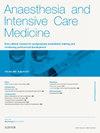Acute pain management and perioperative drugs used in low-resource settings
IF 0.3
Q4 ANESTHESIOLOGY
引用次数: 0
Abstract
The choice of drugs used during the perioperative period in low-resource settings is dictated by numerous factors. The lack of a reliable supply of essential medications coupled with limited provision of trained staff and necessary equipment are the main causative factors. Drugs used may be unfamiliar to anaesthetists from low-resource settings and those available can vary greatly from day to day. For this reason, it is important to develop an understanding of these drugs and their delivery. The management of acute pain benefits from a structured approach such as that used in the RAT model (Recognize, Assess, Treat) from the Essential Pain Management course. This article provides an understanding of the choice of anaesthetic and analgesic drugs used in a low-resource setting with a focus on those used less commonly in a well-resourced setting.
低资源环境中急性疼痛管理和围手术期药物的使用
在资源匮乏的环境中,围手术期药物的选择是由许多因素决定的。缺乏可靠的基本药物供应,加上训练有素的工作人员和必要设备的供应有限,是主要的致病因素。来自低资源环境的麻醉师可能不熟悉所使用的药物,并且每天可用的药物可能变化很大。出于这个原因,了解这些药物及其递送是很重要的。急性疼痛的管理受益于结构化的方法,例如在基本疼痛管理课程中使用的RAT模型(识别,评估,治疗)。本文提供了在低资源环境中使用的麻醉和镇痛药物的选择的理解,重点是那些在资源良好的环境中较少使用的药物。
本文章由计算机程序翻译,如有差异,请以英文原文为准。
求助全文
约1分钟内获得全文
求助全文
来源期刊

Anaesthesia and Intensive Care Medicine
ANESTHESIOLOGY-
CiteScore
0.50
自引率
0.00%
发文量
152
期刊介绍:
Anaesthesia and Intensive Care Medicine, an invaluable source of up-to-date information, with the curriculum of both the Primary and Final FRCA examinations covered over a three-year cycle. Published monthly this ever-updating text book will be an invaluable source for both trainee and experienced anaesthetists. The enthusiastic editorial board, under the guidance of two eminent and experienced series editors, ensures Anaesthesia and Intensive Care Medicine covers all the key topics in a comprehensive and authoritative manner. Articles now include learning objectives and eash issue features MCQs, facilitating self-directed learning and enabling readers at all levels to test their knowledge. Each issue is divided between basic scientific and clinical sections. The basic science articles include anatomy, physiology, pharmacology, physics and clinical measurement, while the clinical sections cover anaesthetic agents and techniques, assessment and perioperative management. Further sections cover audit, trials, statistics, ethical and legal medicine, and the management of acute and chronic pain.
 求助内容:
求助内容: 应助结果提醒方式:
应助结果提醒方式:


